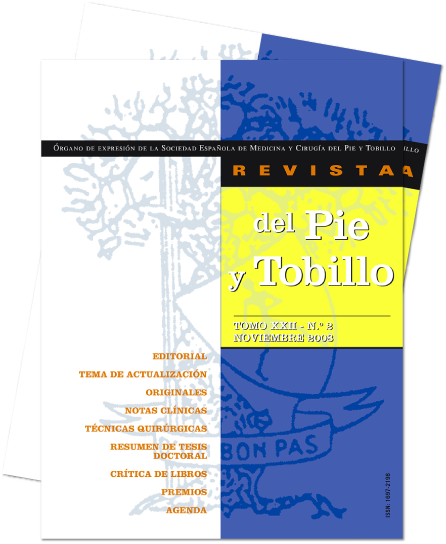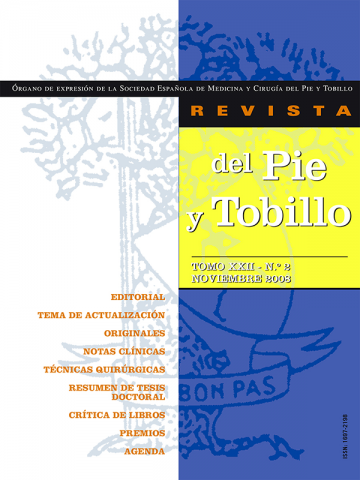Resumen:
Introducción y objetivos: la artrodesis tibioastragalocalcánea es un método quirúrgico de fusión articular que incluye las articulaciones tibiotarsiana y subastragalina con la finalidad de aliviar el dolor y la deformidad con una mayor estabilidad en patologías severas del tobillo. Su principal indicación es la artrosis postraumática. El objetivo de esta comunicación es presentar nuestra experiencia con los clavos intramedulares retrógrados en la artrodesis tibioastragalocalcánea, repasando las indicaciones en las que los hemos empleado.
Material y métodos: presentamos un estudio retrospectivo de 15 artrodesis tibioastragalocalcánea con clavo endomedular retrógrado realizadas en 14 pacientes en el Complejo Asistencial de León. De los 14 pacientes, 9 eran mujeres y 5, hombres, con una edad media de 61,6 años (rango: 44-79). Las causas que indicaron la artrodesis fueron artrosis idiopáticas (5 casos), artrosis postraumáticas (4 casos), fracasos de artrodesis tibiotarsianas convencionales previas (2 casos), aflojamiento de una prótesis de tobillo (1 caso), secuelas de artritis séptica (1 caso), deformidades neurológicas (1 caso) y secuelas de pie zambo (1 caso). Recordamos la técnica del enclavado y el manejo postoperatorio de los pacientes, que se resumió en la descarga del miembro intervenido durante un tiempo medio de 7 semanas y un tiempo medio de inmovilización del tobillo de 10,5 semanas. Analizamos el resultado clínico y radiológico según la escala AOFAS al cabo de un tiempo de seguimiento medio de 17,53 meses.
Resultados: un paciente con insuficiencia respiratoria falleció durante el postoperatorio inmediato debido a complicaciones generales independientes de la patología local. En todos los restantes casos se consiguió la fusión articular en buena posición del tobillo, si bien con las siguientes complicaciones: úlceras cutáneas (4 casos), protrusión del clavo en la región del talón (3 casos), mala colocación de los tornillos de bloqueo (2 casos), fractura por sobrecarga del segundo metatarsiano (1 caso) e infecciones profundas (2 casos). En estos 2 últimos pacientes hubo que extraer el clavo y en 1 de ellos, como consecuencia de la infección, se terminó realizando una amputación infrarrotuliana. Al término del estudio, excluyendo a la paciente fallecida en el postoperatorio inmediato y al amputado, que consideramos fracasos, los resultados obtenidos según la escala AOFAS para el tobillo fueron de una puntuación media de 72 puntos.
Conclusión: los clavos intramedulares retrógrados como método de fijación en artrodesis tibioastragalocalcánea proporcionan una gran estabilidad y parecen facilitar la fusión en artrosis y deformidades severas del tobillo y como rescate de tratamientos previos fallidos. No obstante, no están exentos de complicaciones, que pueden ser graves.
Abstract:
Introduction and objetives: the tibiotalocalcaneal arthrodesis is a surgical method of fusion that includes the talocrural and talocalcaneal articulations with the purpose of relieving the pain and the deformity, giving a bigger stability in severe pathologies of the ankle. Their main indication is the postraumatic osteoarthritis. The objective of this communication is to present our experience with the intramedullary retrograde nail in the tibiotalocalcaneal arthrodesis, reviewing the indications.
Material and methods we present a retrospective study of 15 talocrural arthrodesis with intramedullary retrograde nail carried out in 14 patients in the Hospital of Leon. Nine were women and 9 men, with an average of 61,6 years (range: 44-79). Indications for arthrodesis included were posttraumatic talocrural osteoarthritis (5 cases), idiopatic osteoarthritis (4 cases), failure of previous talocrural arthrodesis (2 cases), loosening of an ankle prothesis (1 case), sequels of septic arthritis (1 case), neurological deformities (1 case) and sequels of clubfoot (1 case). We summarize the intervention technique and the postoperative handling, which included discharge about 7 weeks and an average of immobilization of 10,5 weeks. We analyze the clinical and radiological result according to the scale AOFAS, with a medium follow up of 17,53 months.
Results: one patient with a respiratory failure died during the postoperative due to complications independent general of the local pathology. In all the cases the fusion was achieved in good position of the ankle, although with the following complications: cutaneous ulcers (4 cases), protrusion of the nail under the heel (3 cases), bad placement of the blockade screws (2 cases), fracture overload for of the second metatarsal bone (1 case) and deep tissue infections (2 cases). In these last 2 patients it was necessary to extract the nail and in 1 of them, carrying out an infrapatellar amputation as consequence of the infection. At the end of the study, excluding the patient deceased in the postoperative one immediate and to the one amputated that we consider like failure, the results obtained according to the scale AOFAS for the ankle were of an average of 72 points.
Conclusion: the intramedullary retrograde nail provides a great stability in arthrodesis tibiotalocalcaneal as fixation method and seems to facilitate the fusion in osteoarthritis and severe deformities of the ankle as well as rescue option of bankrupt previous treatments. Nevertheless, they are not exempt of complications that can be serious.





